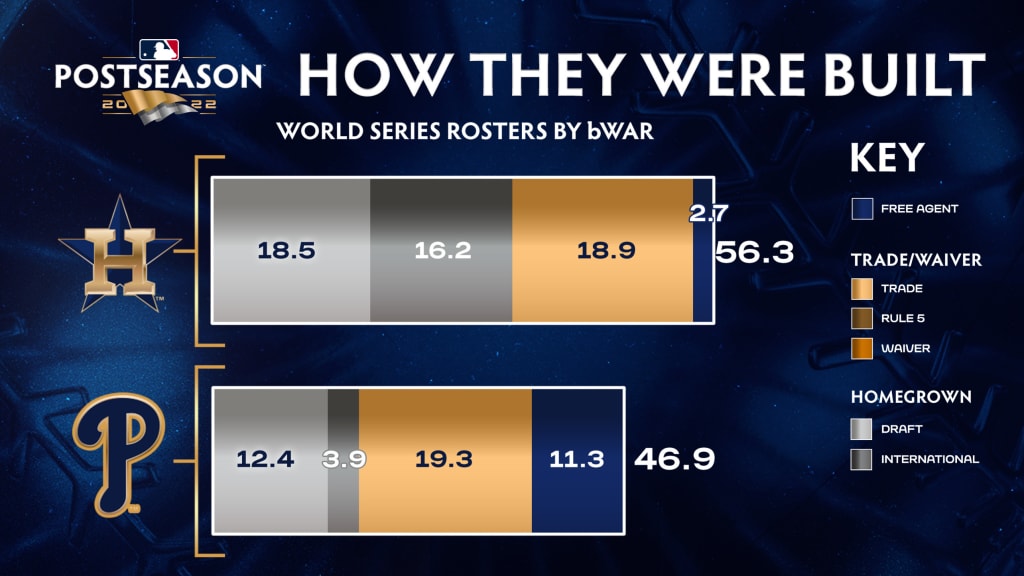
The 118th World Series pits two contrasting teams against each other. A juggernaut against an upstart. A club that built a strong foundation of homegrown talent against one that imported almost all of its best players.
The Astros led the American League with a 106 victories, reached the AL Championship Series for the sixth straight season and are playing in their fourth Fall Classic in that span. They meet the Phillies, who ended an 10-year postseason drought by grabbing the final spot in the expanded playoffs with 87 wins. The World Series begins Friday in Houston at 8 p.m. ET.
Of the 12 playoff teams, none had a roster with more homegrown talent than the Astros, who led in terms of both sheer number of players (14) and production (34.7 WAR, as calculated by Baseball-Reference). They hit big on their pair of top-five-overall picks in the 2015 Draft, Alex Bregman and Kyle Tucker. ALCS MVP Jeremy Peña has blown away expectations for his bat since signing as a 2018 third-rounder, and Chas McCormick was a steal as a 21st-rounder out of NCAA Division II Millersville (Pa.) University the year before.
But Houston has distinguished itself even more on the international market, beginning with signing Jose Altuve for $15,000 out of Venezuela in 2006. But the relatively unsung secret to the Astros' sustained success is their ability to find difference-making starting pitchers for next to nothing internationally. Luis Garcia, Cristian Javier, José Urquidy and Framber Valdez combined for 112 starts and 56 wins this year after originally signing for a combined $140,000
On the other hand, most of the Phillies' best players have arrived via trades and free agency. They made two huge moves in February 2019, shipping Jorge Alfaro, Sixto Sánchez and Will Stewart to the Marlins for J.T. Realmuto and handing a 13-year, $330 million contract to NLCS MVP Bryce Harper. A five-year, $118 million deal for Zack Wheeler that December also has paid off as hoped.
Kyle Schwarber led the NL with 46 homers this season, his first in Philadelphia after signing a four-year, $79 million contract. And when the Phillies needed to plug some holes at the Trade Deadline in August, they swapped prospects for Brandon Marsh, David Robertson and Noah Syndergaard.
After building their cores in different fashion, Houston and Philadelphia added to them in a variety of ways.
For all of their success developing talent from within, the Astros' two best players this year were trade acquisitions Yordan Alvarez and Justin Verlander. They stole Alvarez, who had yet to make his pro debut, in an August 2016 deal that sent Josh Fields to the Dodgers. A year later, they put the final touches on their 2017 World Series championship club by giving up three prime prospects (Daz Cameron, Franklin Pérez, Jake Rogers) to pry Verlander from the Tigers.

Additionally, Ryan Pressly has blossomed into Houston's closer after arriving via a 2018 trade with the Twins for Jorge Alcala and Gilberto Celestino. Ryan Stanek also became a bullpen stalwart after signing as a bargain free agent last year.
While they can't match the Astros' recent success in the Draft and international venues, the Phillies have had some hits. In 2014, they found a pair of cornerstones by selecting Aaron Nola in the first round and Rhys Hoskins in the fifth. Recent first-rounders Alec Bohm (2018) and Bryson Stott (2019) have claimed jobs in the starting lineup.
Philadelphia also landed two of its more trusted arms by signing Seranthony Domínguez and Ranger Suárez for $25,000 out of Latin America a decade ago. They're the only two international players on the club's roster.
This year's World Series reinforces yet again that there are multiple ways in which to assemble a winner. The 2021 Braves and 2020 Dodgers depended more on the Draft, while the 2019 Nationals were fueled by free agents and the 2018 Red Sox were built on trades. We'll find out in the next couple of weeks which strategy proves best this offseason.


